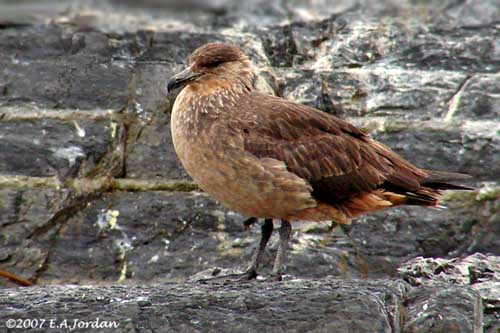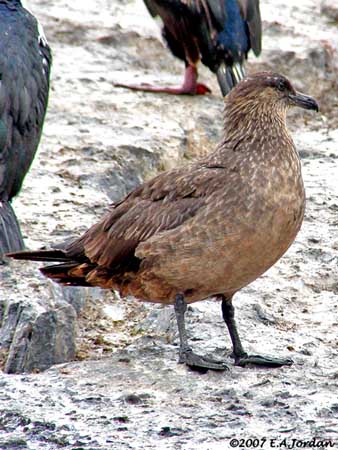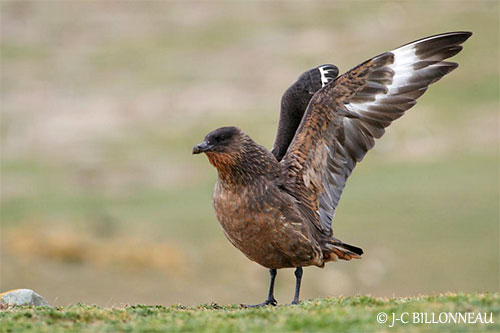
Fr: Labbe du Chili
All : Chileskua
Esp : Págalo Chileno
Esp (Argentine): Escúa Comun, Escúa común
Esp (Chile): Salteador chileno
Ital : Stercorario del Cile
Nd: Chileense Grote Jager
Sd: Chilensk labb
Photographers:
Jean-Claude Billonneau
Photographe-témoin de la Beauté du Monde
Eduardo Andrés Jordan
MIS AVES – AVES DE ARGENTINA
Text by Nicole Bouglouan
Sources:
HANDBOOK OF THE BIRDS OF THE WORLD Vol 3 by Josep del Hoyo-Andrew Elliott-Jordi Sargatal - Lynx Edicions - ISBN : 8487334202
SKUAS AND JAEGERS by Klaus Malling Olsen and Hans Larsson - Pica Press Sussex,
ISBN: 1873403461
BirdLife International (BirdLife International)
Arthur Grosset's Birds (Arthur Grosset)
Chilean Skua
Stercorarius chilensis
Charadriiforme Order – Stercorariidae Family
BIOMETRICS:
Length: 53-58 cm
Wingspan: 130-138 cm
Weight: 1100-1700 g
DESCRIPTION:
The Chilean Skua is slightly smaller than the Brown Skua. Its plumage shows cinnamon tinge, making it different from other skuas.
The adult has brown plumage on the upperparts with dark mantle and scapulars showing paler brown spots or streaks. The upperwing is similar to that of other skuas, with usually a paler leading edge towards the inner wing. We can see broad tips on lesser and median coverts. The tail is dark brown.
The underparts are bright cinnamon in most birds. The breast often shows a darker band, but it may sometimes be absent. Undertail-coverts are rusty.
In worn plumage, the reddish or rufous tinge may disappear, except on cheeks and throat.
On the head, the crown is dark brown to blackish and well defined. It contrasts against the pale rusty cheeks, hind collar and neck sides. During the breeding season, these parts of plumage are conspicuously streaked yellow or white.
The bill is grey with black tip. The eyes are dark brown. Legs and feet are black.
Both sexes are similar.
The juvenile resembles adults and has often stronger cinnamon tinge on the underparts.
The upperparts are darker and more uniform than in adults, with some rufous tips and light scaling on mantle and scapulars. The rump may be cinnamon to reddish-brown.
On the head, the dark crown makes a kind of hood.
Legs are pale bluish-grey and feet are black.
VOICE: SOUNDS BY XENO-CANTO
The Chilean Skua gives series of several “laughs” as territorial call or to greet the mate. While calling, the bird performs the typical “wing-raising displays” to expose the white wing patches.
Its voice is much higher-pitched and more nasal than that of the Brown Skua.

HABITAT:
The Chilean Skua usually frequents the waters of channels and straits, and while being marine, it remains predominantly coastal.
This species breeds on islands and remote coastal areas in Chile and Argentina.
RANGE:
The Chilean Skua is visible along the coasts of S South America, from SC Chile and S Argentina, to S Tierra del Fuego.
It winters along the coasts of Chile and Argentina, extending N to S Peru and probably E to W Falkland Islands.
BEHAVIOUR:
The Chilean Skua often frequents rubbish tips with gulls and terns. But during the breeding season, it takes invertebrates and feeds by scavenging at penguin’s carcasses. This species often feeds by kleptoparasitism and steals the food of medium-sized seabirds, and may prey on phalaropes. It also takes eggs and chicks at gull’s colonies.
The Chilean Skua is the only skua breeding in dense colonies of up to 1000 pairs.
Courtship displays are probably similar to other skuas’ displays, with frequent wing-raising accompanied by calls to advertise the territory. This display enhances the white wing patches.
The Chilean Skua hybridizes with the Brown Skua on the coasts of Argentina.
The migration of this species is poorly known, but post breeding dispersions northwards are reported in April. They return to their breeding grounds in October.

FLIGHT:
The Chilean Skua can appear heavy and clumsy on land, but in the air, it has an agile, speedy and powerful flight.
REPRODUCTION:
The breeding season occurs between November and March.
The Chilean Skua usually breeds in dense gull-like colonies of up to 1000 pairs. Such colonies are established in short-grass areas. But occasionally, this species may also breed in smaller, loose colonies.
The nest is a scrape on the ground, often lined with dead grass.
The female lays two eggs, sometimes only one. Incubation lasts about 28-32 days. At hatching, the chicks are covered in light pink-grey down.
Unlike other skuas, the Chilean Skua does not attack humans entering its territory.
DIET:
The Chilean Skua feeds at rubbish tips. It also scavenges at carcasses of penguins and catches invertebrates. It is known to perform kleptoparasitism and pirates food from other seabirds.
PROTECTION / THREATS / STATUS:
The populations of the Chilean Skua do not appear currently threatened in spite of harvest of eggs and young for food.
This species is evaluated as Least Concern by BirdLife International.
